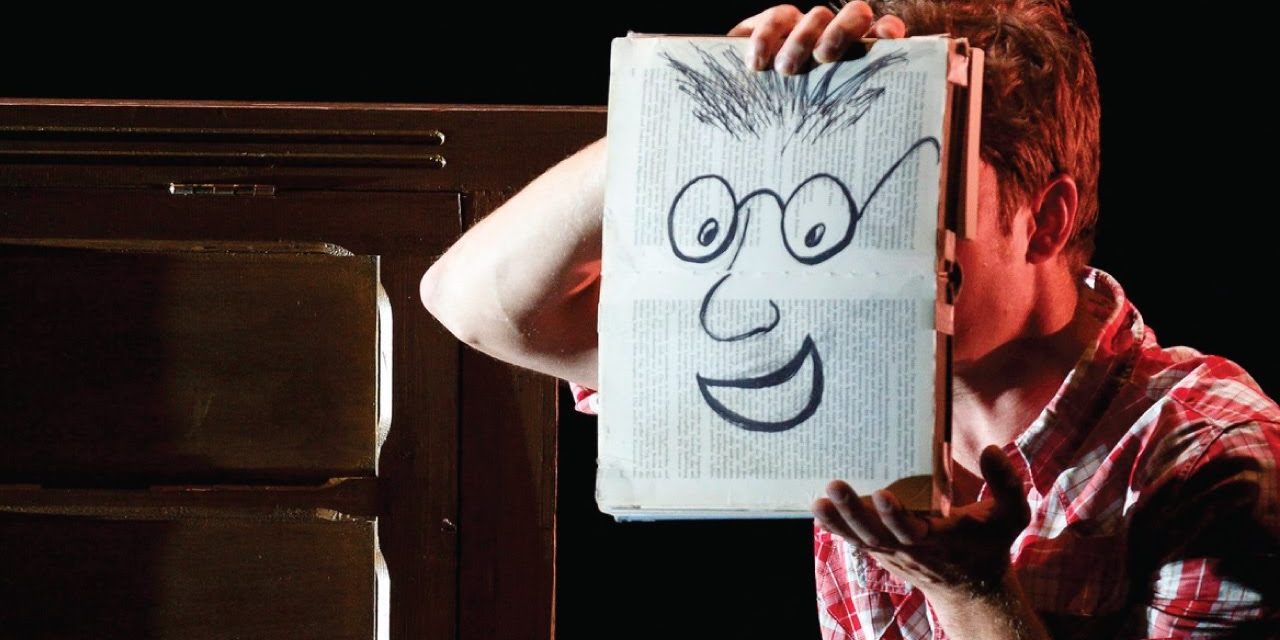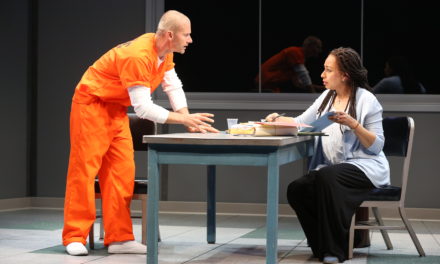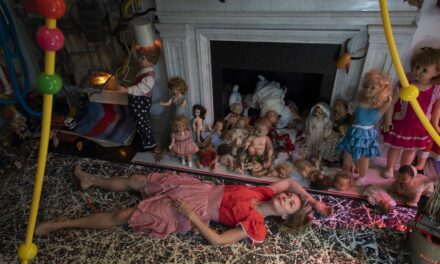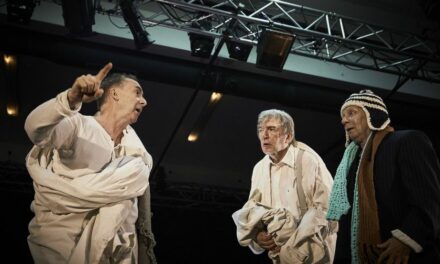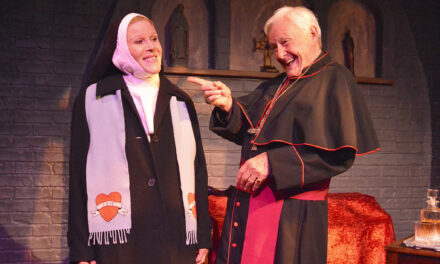
Olivier Letellier directed both the Paris premiere and the English adaptation for Broadway. Photo Credit: frenchculture.org
Following the U.S. premiere of Oh Boy! on Broadway, at the Duke on 42nd Street presented by the New Victory Theater, French newspaper Le Monde published an article about the fabulous adventure of director Olivier Letellier’s production, translated into English and performed by American actor Matthew Brown.
The play first staged eight years ago in the Paris suburbs by Olivier Letellier is now having a resounding success in New York. Meanwhile, a conference for performing arts presenters is in full swing.
The kids started yelling as soon as the lights went down. These sixth-grade students from PS189, a public school deep in Brooklyn, were clowning around, loud and giddy. And then, little by little, the play—the story of a young gay man whose life gets taken over by three half-siblings whose existence was previously unknown to him—spoke to their hearts. They were sucked in by the suspense, like leukemia that nearly swallows up one of the children in Oh Boy!, the novel by Marie-Aude Murail (L’Ecole des loisirs, 2000) that was adapted for the stage by Catherine Verlaguet and directed by Olivier Letellier. At the end of the performance, Benjamin, 11, was so surprised that he turned to his buddy Shain and said: “It’s the first time I like theater.”
New York, 42nd Street, January 11. What a crowning achievement for this show developed eight years ago on a budget of 11,000 euros in Champigny-sur-Marne, in the suburbs of Paris, to land at the New Victory Theater on Broadway! With the same staging and Olivier Letellier still calling the shots, but now in English, in an American production with an American actor.
First staged in 2009 in a small theater in Pont-Scorff, in Brittany, Oh Boy! had only been performed a dozen times when it won a Molière (France’s highest award for theater). Since then, the show has been performed close to 800 times. “Kids here react in the same way, they laugh at the same spots,” Olivier Letellier notes with delight. Amused, Nicholas Elliott, who translated the play into English, looks at him with an indulgent smile: “It’s beautiful to witness the American Dream.”

Matthew Brown in the American Broadway version of Oh Boy!. Photo Credit: frenchculture.org
“They thought I was crazy”
It all starts with Olivier Letellier, 44 years old. The son of a butcher who had taken over a café-restaurant in Champigny, he was very early confronted, like the protagonist of Marie-Aude Murail’s novel, with death (that of his mother) and with his homosexuality. Theatre would be a refuge. He discovered it in his second year of nursery school—the name of his teacher, Jeannine Dumesnil, is forever engraved in his personal Pantheon. It was she who opened the path to theatre to him at Champigny’s Centre Jean-Vilar, just like the New Victory is now doing for these kids from Brooklyn. It was here that the young boy would get a handle on life.
To this day, when he is not on tour with his various plays or in Aix-en-Provence staging an opera, Olivier Letellier, an associate artist at the Théâtre National de Chaillot, continues to works at the Centre Jean-Vilar—“a permanent residency.” It was also here that he brought the American actor Matthew Brown to rehearse in 2016: “It was fun to turn my neighborhood cultural center into a Broadway rehearsal room,” he says with a smile.
Like every January, the performing arts in New York are in a ferment of activity. On three floors of the vast conference rooms of the 6th Avenue Hilton, the annual APAP (Association for Performing Arts Presenters) conference is in full swing. Having traveled here from all over the United States and even, in many cases, from abroad, presenters take their pick of shows from January 6 to 10, while artists, producers, and agents offer their productions.
Promoting a project formatted for the American market—an unknown singer (Anne Carrère) playing a global cliché (Edith Piaf)—Gil Marsalla from Nice has a hit on his hands. To achieve that, he went all out and rented Carnegie Hall for the conference’s opening night. “They thought I was crazy. But in two days here, I signed agreements for forty performances, more than in three years of touring since the show was first staged,” he reports, stunned. “Things move very fast here. In five minutes, it’s a done deal.”
“If the government stops helping us, it won’t change anything”
At the Public Theater, the nerve center of the Off-Broadway scene, Mark Russell mimics a theatre presenter in town to take his pick of shows: “So, I need a comedy, 25,000 dollars, OK, here you go… an opera, yup, there you are… a jazz concert…” He laughs: “You know, I like APAP, it’s the way America can deal with culture: like a financial market. And if it weren’t for APAP, we never would have existed.”
At 62, Mark Russell, formerly the first artistic director of the celebrated New York theater PS122, now runs Under the Radar, the most important of the eight festivals held all over town during the conference. “We dream of your French system,” he says. “Our system only has one advantage, but these days it’s not an insignificant one: since we have multiples sources of revenue, if the government stops helping us, it won’t change anything.”
Here, financing is entirely based on the patronage of private foundations. The National Endowment for the Arts, the government agency responsible for culture, has a budget of 150 million dollars (141 million euros). By comparison, the budget of the French ministry for culture is over 7 billion euros. From his suite on top of the Hilton, Mario Garcia Durham, the president of APAP, sighs: “The electoral campaign depressed us all. But Trump’s election won’t have much impact on culture, and paradoxically it was under Nixon and Bush Jr that culture was best served.”
While the United States is a desert for performing arts outside of the major urban centers—Los Angeles, San Francisco, Portland, Austin, Chicago, Minneapolis, Miami—New York remains the form’s uncontested hub.
In the wake of the Wooster Group, artists such as John Collins (Elevator Repair Service), Richard Maxwell (New York City Players), Abigail Browde and Michael Silverstone (600 Highwaymen), Tina Satter (Half Straddle), and Young Jean Lee are the standard-bearers of contemporary theater-making. Raised all over the map, they chose to live in New York. “Partially because there is a philanthropic tradition for emerging artists here,” explains Mark Russell, who grew up and went to school in Austin, Texas, before moving to New York. “The hard part comes later: once you’ve been discovered, where do you go?”

David Eden, a specialist who works on several foreign tours, explains “Though there is obviously an audience for French performing arts here, this is a terribly isolated country. And the arrival of Trump is not going to help.” Photo Credit: frenchculture.org
“It’s time to wake up”
By comparison with European standards, even New York is lacking venues for contemporary performance. Aside from the Public Theater, there is The Wooster Group’s Performing Garage, the tiny Dixon Place, the Chocolate Factory in Queens, and The Kitchen in Chelsea, where the company led by Philippe Quesne (Les Amandiers, Nanterre) performed La Mélancolie des Dragons in January.
This situation has to be met with imagination: following MoMA’s example, museums open their doors to performances. On December 21, 2016, as the first sun of winter was rising, one could witness some hundred spectators slipping into the Whitney Museum to see a performance directed by Sibyl Kempson, who is working here on the subject of solstices.
But with Donald Trump’s rise to power, this winter has a bitter taste. Drew Klein, the performance curator at the Contemporary Arts Center in Cincinnati, Ohio, is feeling the pain: “We were lazy, we let ourselves be lured into a kind of comfort. It’s time to wake up. The election is forcing us to redefine the value of art and of what artists have to say.”
Angela Mattox, the artistic director of the Institute for Contemporary Art in Portland, Oregon, agrees: “For all these communities that feel threatened, it is important to show that our theaters are safe spaces that encourage discussion.”
Both Klein and Mattox are at the Abrons Arts Center on the Lower East Side to organize a fall tour by the Moroccan artist Bouchra Ouizguen with other partners—including the head of Abrons and a team from the French embassy. “We make our artistic choices freely,” Angela Mattox explains, “but the difficult part is pooling our resources to get financing and put together tours. Even visas have become expensive and complicated for artists. For Bouchra Ouizguen, for example, we’re going to have to spend 8000 dollars… Putting these tours together heavily relies on French cultural services.”
“The financial realities are increasingly difficult”
One has to travel abroad to realize the extent to which our heavily criticized system of subsidies is an extraordinary help to the arts. Everyone here knows Rima Abdul-Malak, the cultural attaché for performing and visual arts in New York, and Nicole Birmann-Bloom, a program officer who has been part of the scene for more than twenty years. They were the ones who brought Oh Boy! With the financial support of the French Institute, the French ministry of culture, and the Société des Auteurs et Compositeurs Dramatiques (SACD, Society of Dramatic Authors and Composers), they commissioned the translation and produced an initial staged reading that ultimately convinced the artistic director of the New Victory to take a chance on the play.
The challenge is now to sell the play in a country that is not used to productions for young audiences. Jim Leija, a presenter in Ann Arbor, Michigan, sees the show and claps enthusiastically. “It’s time that we started producing shows addressed to teens, like this one,” he exclaims. But success is far from guaranteed, and Olivier Letellier’s team would like David Eden to come see the show. At 68, this old pro born in Riga and raised peripatetically is a specialist of tours by foreign companies ranging from the Bolshoi to the Théâtre de la Ville de Paris.

“Sadly,” he explains mezza voce in a Broadway bar, “the financial realities are increasingly difficult. The theaters are no longer able to pay what they used to give. The universities offer less because the student audience doesn’t come out as much anymore. Though there is obviously an audience for French performing arts here, this is a terribly isolated country. And the arrival of Trump is not going to help.”
A single figure gives pause for thought: 3% of the books published in the United States are translations of foreign authors, and only 1% for fiction, according to Chad W. Post, the publisher of the University of Rochester’s Open Letter press. In France, 30% of books are translations. At APAP, on the third floor of the Hilton, a panel with a resonant topic is coming to a close: “Breaking Down Walls While Countries Build Them”.
In Russia, the novel is forbidden to readers under 18
In New York to see the play, Marie-Aude Murail, the author of Oh Boy! (L’Ecole des loisirs, 2000), tells me she was surprised when she traveled to the Moscow book fair in December 2016. “I had never seen such a long line for my books,” the author smiles. Except that in Russia, the book, a success upon its original publication by Samokat in 2006, has had its new edition, published a decade later, blacklisted (its protagonist is gay) due to the new Russian law “against propaganda for non-traditional relations aimed at minors.”
This post was written by the author in their personal capacity.The opinions expressed in this article are the author’s own and do not reflect the view of The Theatre Times, their staff or collaborators.
This post was written by Laurent Carpentier.
The views expressed here belong to the author and do not necessarily reflect our views and opinions.

